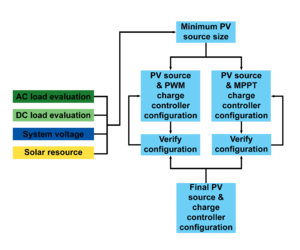PV source and charge controller sizing and selection overview
Jump to navigation
Jump to search
The most complicated part of the design process involves sizing and configuring the PV source as it must be done in conjunction with the sizing and selection of the charge controller. This process may need to be performed various times until the ideal design is found for the project, but going through this process will becomes simpler with each subsquent design. There are many different design parameters in this process for which conservative values and appropriate values from component specifications sheets should be used.
The main inputs to this process are:
- DC load evaluation - included in average daily Watt-hours required for the design month and used to size the PV source.
- AC load evaluation - included in average daily Watt-hours required for the design month and used to size the PV source.
- DC system voltage - used to determine potential PV module and charge controller configurations.
- Solar resource - used to determine required PV source size to meet daily energy needs.
The primary steps in the process are:
- Determine minimum PV source size
- Choose a charge controller type: MPPT charge controller sizing and selection process or PWM charge controller sizing and selection process.
- Choose a PV module size.
- Create a charge controller and PV source (series and parallel) configuration.
- Verify that the charge controller and PV source combination will function well.
- If the charge controller and PV module configuration is not a good design, then restart with a different combination.
- Determine a final charge controller and PV source configuration that is the best balance between performance and cost.
